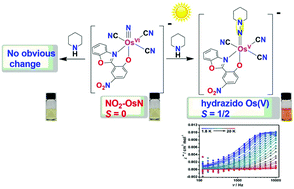Field-induced slow magnetic relaxation in low-spin S = 1/2 mononuclear osmium(v) complexes†
Abstract
Photochemical reactions of (PPh4)[OsVI(N)(L)(CN)3] (NO2-OsN) with piperidine and pyrrolidine afforded two osmium(V) hydrazido compounds, (PPh4)[OsV(L)(CN)3(NNC5H10)] ([PPh4]1) and (PPh4)[OsV(L)(CN)3(NNC4H8)] ([PPh4]2), respectively. Their structures consist of isolated, mononuclear distorted octahedral osmium anions that are well-separated from each other by PPh4+. Their low spin S = 1/2 and L = 1 ground state was confirmed by magnetometry and DFT calculations. Interestingly, both compounds exhibit slow magnetic relaxation under a bias dc-field. These osmium(V) complexes are potentially useful building-blocks for the construction of molecule-based architectures with interesting magnetic properties. In contrast, the structurally related (PPh4)[OsIII(L)(CN)3(NH3)] ([PPh4]3), which also has a low-spin S = 1/2 ground state but with a different electronic configuration (5d5), does not exhibit slow magnetic relaxation, due to the absence of any orbital moment (L = 0). Furthermore, the structurally different osmium(V) hydrazido compound reported by Meyer, [OsV(tpy)(Cl)2(NNC5H10)](PF6) (4[PF6]), also does not exhibit slow magnetic relaxation due possibly to a change in magnetic anisotropy from axial for [PPh4]1 and [PPh4]2 to planar.



 Please wait while we load your content...
Please wait while we load your content...